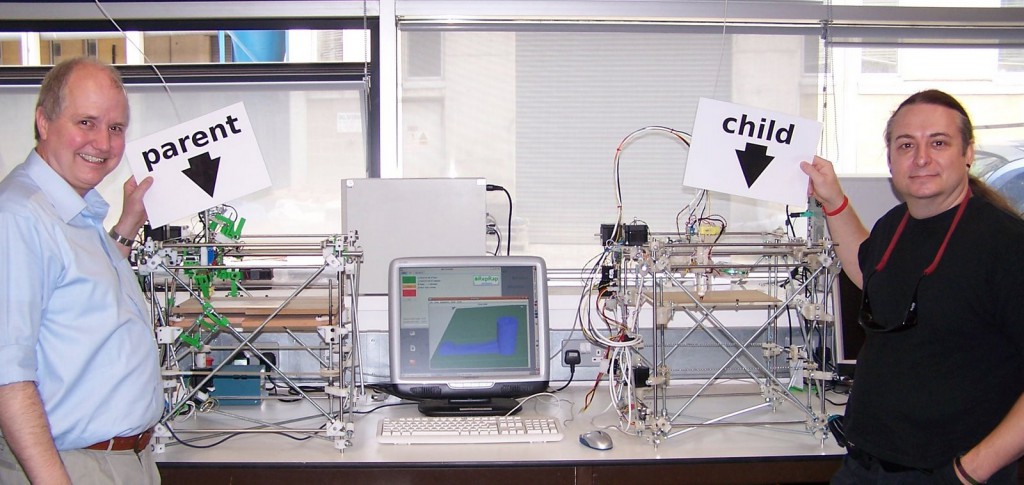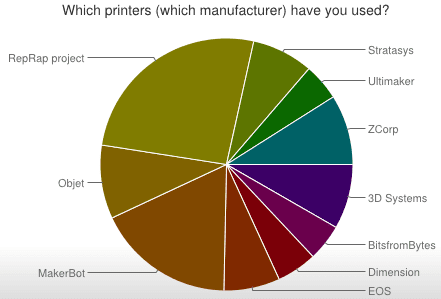What is 3D printing?
A 3D printer is used to “print” 3D objects by depositing molten plastic or another material one layer after another, in a computer-controlled pattern. Industrial 3D printing has existed for decades, with patents owned by Stratasys (combined with technology acquired from IBM) dominating the “rapid prototyping” market since the mid 1990s with equipment costing upwards of $20,000.
But what really makes 3D printers so interesting today is not just that schools can acquire one for only one tenth of that price and use it in in arts and industrial design classes. Yes, that’s very cool, but it’s merely using the 3D printer simply as a consumer product, just like for instance a laser printer or DVD player. That’s really a pity, because it’s so much more – but to see that, we must look beyond the ready-out-of-the-box 3D printers that are now available and the most commonly seen, and understand how this technology became accessible. It’s not regular market progression that got us here!
It is very important to realise is that a 3D printer is a workshop tool, like a lathe or a circular saw. Its popular naming is confusing, having many people think that it’s supposed to work as easily as an inkjet or laser printer (then again, don’t we all have hassles with them!). Operating and maintaining a 3D printer is an acquired skill. Fortunately, the concepts are not complicated and high school age kids are already able to get to grips with it all.
See this video interview with OpenSTEM’s Arjen for a quick overview – read on below.
Have you heard of the RepRap project?
The RepRap project
 In 2005 the RepRap project was started at the University of Bath (UK) by Dr Adrian Bowyer. Its objective was to develop a 3D printing system from scratch, using cheap and readily available components.
In 2005 the RepRap project was started at the University of Bath (UK) by Dr Adrian Bowyer. Its objective was to develop a 3D printing system from scratch, using cheap and readily available components.
With the key IBM/Stratasys patents close to expiring, there was no longer a hindrance to others developing similar technologies.
 By May 2008 the RepRap team had a first working model, Darwin (shown on right). It was built around a cube frame made of metal rods and plastic. The initial plastic parts had been printed using an industrial 3D printer, although there are people who have made those components from wood!
By May 2008 the RepRap team had a first working model, Darwin (shown on right). It was built around a cube frame made of metal rods and plastic. The initial plastic parts had been printed using an industrial 3D printer, although there are people who have made those components from wood!
Subsequent copies printed were by Darwins themselves – so the system can produce its own custom parts. The other components that make up a RepRap are all readily available and cheap, or can be easily substituted. People have indeed built RepRaps from scrap wood/metal.

Australia
In 2010, Arjen co-funded the first Darwin based RepRap in Brisbane (pictured on the right), a kit from UK with a lot of laser cut acrylic, mostly assembled by James Churchill. It was a very finicky piece of engineering, but it sparked off a lot of activity in HS-BNE (Brisbane Hackerspace) and beyond.
A Changed Global Market
By 2012, RepRap had changed the landscape. New companies were springing up around the globe, developing further improved models and software based on common designs and collaboration.

The really interesting thing is that the earlier Stratasys market hadn’t been fragmented, from what we know the original Stratasys market share was maintained and may even have grown during this period (note that a few years ago, Stratasys acquired MakerBot Industries).
The market expanded by a huge amount, and it has grown further since! While it was obviously the right idea at the right time, the actual work still had to be done and it can only be attributed to the tremendous efforts by those involved in RepRap project.
Today
3D printing is now available to pretty much anyone, and from a very reasonable price point. However, it is important to realise that 3D printers are engineering workshop tools, requiring specific skills to assemble, operate and maintain. Contrary to popular marketing, they are not at all like inkjet/laserjet printers.
The starter cost depends on whether you’re going to build some or all of the system yourself, or buying a kit or complete product.
- Build from scratch from $500 + quite a bit of time
- Complete kits between $600-$2000 + some time and skill
- Ready built $1000-… + operating/maintenance skills
Whichever range you choose, the print quality is astonishing, down to micron-level precision.
Consider maintenance, if you purchase a turn-key product it’s likely to contain custom components that you will not be able to maintain yourself. For a workshop tool, that can become a costly nuisance.
Getting a 3D Printer for your school

 OpenSTEM recommends the Australian designed and built Wombot series of 3D printers. You can order Wombot 3D printers and quality filament (also manufactured in Australia!) through the OpenSTEM store.
OpenSTEM recommends the Australian designed and built Wombot series of 3D printers. You can order Wombot 3D printers and quality filament (also manufactured in Australia!) through the OpenSTEM store.
Ask us for advice for your educational needs, including OpenSTEM workshops and other assistance to get to know your 3D printer (for staff as well as students!) and learn about how to operate, tune and maintain your printer.


Aunt Madge's Suitcase was a really fun activity! The children were really interested in all the places she travelled to,…
Indi Alford, Teacher